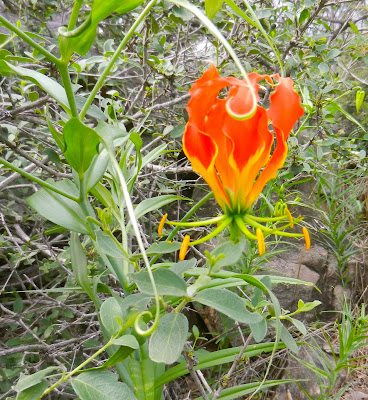It's 7.30pm, we're back from afternoon game drive and from the balcony of Rock Lodge we watch lightening flash across the sky. The rainy season. We know what this means... mud, lots of it, uncrossable rivers, wet game drives and bush so thick spotting animals seems almost impossible. And yet we're relieved, the land desperately needs the water, and finally there will be more vegetation and food available for the game. Of the game itself, an exciting period begins, first with the Impala's dropping their lambs and within days of the first rains the bush erupts with life.
 |
| Lion's eye |
One of the most interesting changes is the arrival of the wild flowers. Its not just the animals you can tick off your "seen" lists now, but their flower counterparts, too...cue Lion's eye, Leopard Orchid and Impala Lily. Although the Fynbos region at the southern tip of Africa is far better known than the Savanna for flowers, we certainly have our fair share of beautiful specimens here, a few that would impress even those uninterested in such things.
 |
| Impala Lily (Adenium multiflorum) |
 |
| Madagascar periwinkle (Catharanthus roseus) |
Aside from their beauty, their usefulness is worth a mention as well. The Madagascar periwinkle (Catharanthus roseus), for example, is traditionally used in South Africa as a remedy for diabetes and to treat rheumatism. You can use the leaves of the Devils thorn (Harpagophytum Procumbens) to make soap when mixed with water, and the Blue water-lily (Nymphae nouchali) is used by the local zulu people in a love charm ritual, in which a partner can be attracted and a permanent bond established by consuming the roots of the water-lily early in the morning.
So next time your on game drive, bouncing from one big-5 sighting to the next, keep your eyes open for the wild flowers, there is more to them than meets the eye!
 |
| Flame lily (Gloriosa superba) |
 |
| Blue water-lily (Nymphae nouchali) - photo thanks to Ryan Johnston) |
 |
| Yellow mouse ears (Cleome angustifolia) |
 |
| White trumpets (Chascanum haderecium) |
 |
| Wild African violet (Aptosmium lineare) |
No comments:
Post a Comment